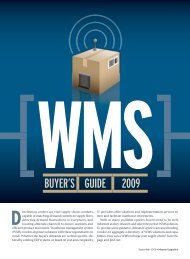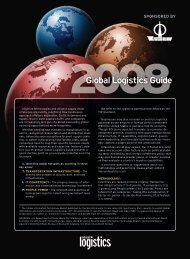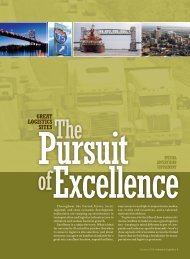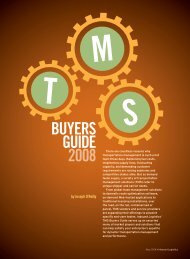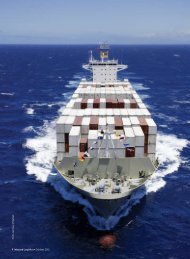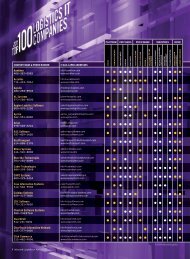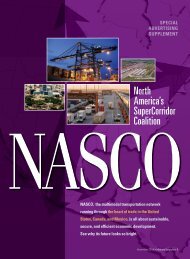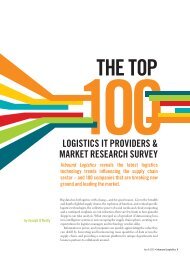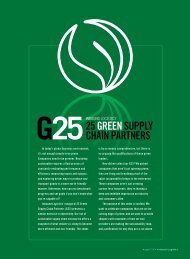Inbound Logistics | G75: Green Supply Chain Partners | Digital Edition
Inbound Logistics | G75: Green Supply Chain Partners | Digital Edition
Inbound Logistics | G75: Green Supply Chain Partners | Digital Edition
You also want an ePaper? Increase the reach of your titles
YUMPU automatically turns print PDFs into web optimized ePapers that Google loves.
INBOUND LOGISTICS’75 GREEN SUPPLY CHAIN PARTNERS75 GREEN SUPPLY CHAIN PARTNERS<strong>Inbound</strong> <strong>Logistics</strong>’ methodology for selecting75 <strong>Green</strong> <strong>Supply</strong> <strong>Chain</strong> <strong>Partners</strong> (<strong>G75</strong>) considers acompany’s involvement in three areas: participationin public-private partnerships; corporate sustainabilityinitiatives; and collaborative customer-driven projects.Within this context, four benchmarks carry weight inour decision-making: measurable green results, sustainabilityinnovation, continuous improvement, andindustry recognition.As part of our due diligence, IL editors solicitedmore than 200 transportation and logistics companiesto complete a questionnaire specifying theirinvestments in sustainability — ranging from fuel-efficientequipment to corporate-sponsored recyclingprograms, and everything in between. We also conductedour own research, online and over the phone.Our focus centers on asset-based companies thathave demonstrated measurable progress over the pastfew years as they integrate sustainability into theirrespective enterprises. The list does not include companiesthat tout technology or intellectual capital asgreen enablers. It’s not just a matter of being a facilitatorand responding to customer demand; we valuecompanies that are leading by example.June 2012 • <strong>Inbound</strong> <strong>Logistics</strong> 35
INBOUND LOGISTICS’75 GREEN SUPPLY CHAIN PARTNERSAEP River OperationsAEP River Operations recently received the2011 WorkBoat Environmental Initiative Award.The recognition, given to businesses andgovernment operations serving the U.S. maritimeindustry, judges nominees on successful effortsto incorporate environmentally sustainablepractices into daily maritime operations;innovation, leadership and/or commitment towardenvironmental stewardship; and compliancewith local, state, and federal environmentalregulations and requirements.Aspen <strong>Logistics</strong>Aspen <strong>Logistics</strong> won the Orion EnvironmentalStewardship Award for retrofitting facilities withhigh-efficiency fluorescent lighting. Additionally,the 3PL’s tractors are equipped with emissioncontrol reduction technologies, and it is certifiedby the California Air Resources Board regulations.Aspen has also been recognized by SouthernCalifornia Edison for power savings in Salt LakeCity, Utah, and Victorville, Calif.C.H. RobinsonWorldwide, Inc.C.H. Robinson offers services that optimize businessprocesses to efficiently use transportation anddistribution network resources, ultimately drivingout costs and minimizing carbon emissions. Forexample, the company’s produce sourcing programshelp reduce the distance from farm to table. Workingdirectly with growers and retail customers helpsallocate natural resources wisely and builds efficientfarm-to-shelf distribution models.Eco-friendly truck | CardinalCardinal <strong>Logistics</strong>Management CorporationCardinal <strong>Logistics</strong> has invested in its fleet tohelp reduce fuel consumption and emissions,including installing auxiliary power units, settingautomatic idle shutdowns, and increasing MPGefficiency by governing power unit speed limits.The company is also testing renewable fuels,investing in driver training, using technology tomonitor vehicle performance, and creating moredynamic routing instructions that reduce milesand maximize backhaul opportunities.CEVA <strong>Logistics</strong>Solar-powered warehouse | CEVA <strong>Logistics</strong>In 2008, CEVA introduced a corporate-wide program to reduce the environmental footprint of itsbusiness activities. More recently, the company shifted its attention to managing the environmentalimpact of the full product lifecycle, including the supply chain. This includes measuring and reducingcustomers’ carbon footprints and emissions in warehouses, and improving fuel efficiency.DB SchenkerDB Schenker’s intermodal division helps shipperschoose the optimal transportation mode throughits online EcoTransIT World tool. The solutionidentifies a shipment’s environmental impactin terms of direct energy consumption andemissions during transportation, and calculatesthe indirect fuel consumption and emissionsrelated to production, transportation, anddistribution of energy required for operatingvehicles. DB Schenker Rail also uses windturbines to power its freight trains.Alternative energy | DB Schenker36 <strong>Inbound</strong> <strong>Logistics</strong> • June 2012
3PLsDSC <strong>Logistics</strong>One of the 3PL’s 2012 green goals includescreating a DSC Sustainable Facility Certificationto recognize sustainability achievements.<strong>Logistics</strong> centers will strive to implementspecific items on a checklist – for example,high-efficiency lighting, low water use toilets,auto shut-off faucets, recycling programs,and motion-activated lights. The checklistsprovide instructions for the facilities, while alsosuggesting resources to help them achieve thesegoals. Upon attaining a certain percentage oflisted items, facilities will be awarded Platinum,Gold, or Silver certifications.EA <strong>Logistics</strong>“Delivered GrEAn” is EA <strong>Logistics</strong>’ mantra, andthe company has incorporated this commitmentinto its business value proposition. It computesemissions and provides shippers with freereforestation offsets to neutralize the CO 2emissions from their shipments; its facility andhouse trucks are 100-percent carbon neutral; ituses biodiesel in its truck fleet and encouragesbiodiesel use among vendors; it has a no-idlingpolicy at its facility; and drivers adhere to speedrestrictions to reduce fuel consumption.GENCO ATCHydrogen fueling station | GENCO ATCGENCO ATC’s focus on product lifecycle logisticsallows it to reduce waste and energy consumptionacross the entire supply chain. Manufacturing,packaging, distribution, reverse logistics, repair,and other logistics functions often operate inisolation. Combining and optimizing these areashas a positive impact on the environment andthe bottom line. GENCO ATC’s holistic approachto supply chain business process improvementallows companies to integrate siloed logisticsactivities, then cut cycle times, reduce freightruns, and eliminate carbon emissions.Geodis WilsonUrban delivery | Geodis WilsonGeodis Wilson’s Blue Attitude Program is an internal promotion campaign that showcases andpromotes sustainable development initiatives implemented in partnership with customers. Forexample, Geodis Wilson France set up an initiative in 2009 to reduce energy use and the number ofproducts consumed in certain processes, as well as to improve on-site waste recycling – with a goal ofcovering 50 percent of emissions with offsets.Hub GroupConverting truckload shipments to rail movesplaces Hub Group on the greening edge of thesustainability movement. Intermodal slashesfuel consumption and carbon emissions by asmuch as 65 percent for long-haul shipments.Rail is three times more efficient than truck, andrailroad cars can move one ton of freight closeto 500 miles on one gallon of fuel. Transferringtruckload freight to rail also goes a long waytoward eliminating congestion and reducing wearand tear on U.S. road systems.InmarInmar approaches sustainability broadly,eliminating waste – regardless of source –in product that goes to landfill, in redundantprocesses, and in inefficient transportationmodels that increase carbon footprint and costs.In 2011, Inmar’s sustainability initiatives helpedconvert 3.4 tons of waste to energy, saving morethan 3,880 barrels of oil and generating 2,185megawatt hours of renewable energy – enough topower 190 homes for one year.June 2012 • <strong>Inbound</strong> <strong>Logistics</strong> 37
INBOUND LOGISTICS’75 GREEN SUPPLY CHAIN PARTNERSNFISolar installation | Kenco Logistic ServicesKenco Logistic ServicesKenco Logistic Services recently upgraded lighting at two customer-managed facilities in Chattanooga,Tenn., to reduce electricity use by 70 percent. The energy-efficient, high-intensity fluorescent lightsuse sensors to adjust warehouse lighting, automatically dimming when sunlight pours through thewarehouse skylights and increasing light intensity at night and on cloudy days. The lighting array savesabout 670,000 kilowatt hours annually. The project is anticipated to reduce greenhouse gas emissionsby 14,000 tons over the fixtures’ 20-year lifecycle. This is the air-scrubbing equivalent of a 149-acreforest, or removing 137 cars from the road, according to the U.S. Environmental Protection Agency.As part of the NFI Fit Fleet, the company hasequipped tractors and trailers to reduce theircarbon footprint and increase environmentalfriendliness. It has also been testing the useof natural gas in its fleet. In addition, NFI’sintermodal department, NFI RoadRail, providesa transportation solution that double-stackscontainers, and its solar division is dedicatedto harvesting renewable energy to reduce utilitycosts.LyndenLynden has focused green efforts on streamliningthe performance of its assets. Its new cabdesign – with roof fairing, integrated sleeper,and aerodynamic mirrors and bumper – reducesdrag. Lynden’s tank trucks are equipped with ajacketing system and belly pan to cover crossmembersand enclose outriggers and bolsters.The company is also experimenting with sideskirts, “weed burner” exhaust (in which theexhaust pipe points down rather than up), andpartnering with Washington State University’sCollege of Engineering to model and refine theaerodynamics of milk tank trucks in its windtunnel.Fit Fleet | NFIPenske <strong>Logistics</strong>Penske’s commitment to sustainability focuses on responsible operations,improving fuel economy, and streamlining waste. As testament to thiscause, Penske Truck Leasing, Penske <strong>Logistics</strong>, and Penske Truck Rentalall participate in and support the U.S. Environmental Protection Agency’sSmartWay Transport partnership as affiliate, carrier, and logistics partners.From a logistics standpoint, the 3PL helps shippers analyze and reduce theircarbon footprints through better route optimization and trailer loading andunloading procedures.Performance TeamFrom transportation operations to site selection, Performance Team’s greenefforts run through every facet of its company. For example, the companyhas improved aerodynamics and road safety by installing EPA SmartWaycertifiedhybrid trailer skirts on its trucks, and it now operates more than70 Kenworth Clean Diesel tractors in its fleet. It also has a mandatory “noidling” policy. In terms of network design, Performance Team relocated atransload facility in South Carolina to an on-port terminal, eliminating a50-mile drayage to inland Charleston operations. One customer estimatesthat it will eliminate 90,000 miles annually because of this move.38 <strong>Inbound</strong> <strong>Logistics</strong> • June 2012
3PLsRyderIn 2012, Ryder began offering customers theopportunity to take part in its <strong>Green</strong> Challenge,an innovative approach to optimizing supplychain processes. In addition to measuring thecost savings and efficiency gains of traditionalsupply chain improvements, the <strong>Green</strong> Challengeprovides new avenues to make customers“greener.” With the program, Ryder demonstrateshow an alternative greener supply chain solutioncan help them significantly lower carbonemissions versus a model traditionally optimizedfor the lowest cost. The <strong>Green</strong> Challengedesign takes into consideration three areas:transportation, facilities and building use, andnetwork design.Natural-gas vehicle | RyderSaddle Creek <strong>Logistics</strong>ServicesSaddle Creek <strong>Logistics</strong> Services has invested inalternative fuel vehicles for its for-hire fleet as part ofthe company’s commitment to sustainability. The newtrucks run on compressed natural gas (CNG), one ofthe cleanest-burning alternative fuel options availablewith near-zero emissions. Saddle Creek purchased 40Freightliner CNG trucks in fall 2011 and plans to have120 in its fleet by 2013. The first wave of tractors willreduce the fleet’s carbon footprint by 4.2 million poundsof carbon per year – the equivalent of taking 364 carsoff the road.CNG-powered truck | Saddle Creek <strong>Logistics</strong> ServicesTransGroupThe 3PL’s TransNeutral offering is an opt-in program that analyzesshipment-specific carbon footprints and enables companies to offset theCO 2emissions that result from their shipments. Specifically, it uses aweight-based calculation to determine the amount of climate-effectinggreenhouse gases a shipment emits. It then offsets those emissions bycontributing to emission reduction programs involving reforestation, windpower, and biofuel-related farm renewal projects.TransplaceWorking with Sunny Delight Beverages Co., Transplace recently completeda successful implementation of a compressed natural gas fleet in southernCalifornia. The initiative has effectively lowered greenhouse gas emissionsand reduced fuel costs for the beverage company. The five-year arrangementwill transport Sunny Delight products to customers across the southernCalifornia market to cities such as Los Angeles, Mira Loma, Carson, andRiverside. Sunny Delight’s network stands to save an estimated 400,000gallons of diesel fuel in 2012 due to the conversion.June 2012 • <strong>Inbound</strong> <strong>Logistics</strong> 39
INBOUND LOGISTICS’75 GREEN SUPPLY CHAIN PARTNERSUTiUTi recently undertook a project to evaluateopportunities for overall environmentalimprovement in its multi-client contract logisticsfacilities. One key recommendation was toimplement processes and machinery that recycledunnage into packing material for pick-and-packoperations. The 3PL expects this effort to divertall scrap cardboard, and eliminate much of theplastic packing material currently used in thoseoperations.Weber <strong>Logistics</strong>Over the past three years, Weber has reducedits fleet’s carbon emissions by 37 percent –the equivalent of removing 2,047 cars from theroad every year. In its warehouses, innovativelighting solutions have reduced electrical usageup to 30 percent, creating cost savings for itsclients while reducing pollution. Weber has alsomade efforts to bring vendors in line with its ownsustainability efforts.Renewable energy | Wheels GroupWerner EnterprisesWerner Enterprises is investing in technologies, proactive strategies, and policies that increase fuelefficiency and decrease carbon emissions. The company is testing and implementing technologies thatinclude wide-base tires/low rolling resistant tires, tire inflation systems, idle reduction tools, trailertails, and its proprietary, SmartWay-certified advanced trailer skirt, ArrowShield. From 2007 to 2011,the company reduced its carbon footprint by 209,171 tons of CO 2and the amount of fuel burned bynearly 19 million gallons. It has also reduced idling time 33 percent.Wheels GroupLow-emissions vehicle | Werner EnterprisesWheels Group’s green policy is to consistently seek measures that willreduce activities that negatively impact the environment, and ultimatelyminimize its carbon output. The company has formed a <strong>Green</strong> Team withexecutive sponsorship to oversee a variety of projects that support itsaim toward carbon neutrality. Wheel Group’s strategy focuses specificallyon waste reduction, recycling, re-use of materials, reducing energyconsumption, migrating to renewable energy purchases, and working as anorganization to achieve carbon neutrality.Yusen <strong>Logistics</strong>Yusen <strong>Logistics</strong> has made efforts to create its own standards with regardsto environmental protection. Globally, it is acquiring the ISO 14001:2004Environmental Management Standard across facilities to help improveenvironmental performance, and set targets and objectives. For example,Yusen has developed a closed-loop logistics process intended to reduce thesupply chain’s overall effect on the environment. The process emphasizesre-using and recycling materials, and includes end-of-life disposal optionsfor products.40 <strong>Inbound</strong> <strong>Logistics</strong> • June 2012
AIR/EXPEDITEDElectric delivery van | DHLAmerican AirlinesIn 2011, American Airlines ordered 460 newplanes from Boeing and Airbus. The airlineexpects the new aircraft to dramatically reducecosts because the planes are more fuel-effi cientand require less maintenance than a moremature fl eet. American’s Fuel Smart programhas saved more than 500 million gallons of fuelin fi ve years, and reduced CO 2emissions by2.6 billion pounds annually through initiativessuch as reducing auxiliary power use, singleenginetaxiing, wing tip extensions, andhigh-speed tow tractors.FedExIn a new program called FedEx carbon-neutralenvelope shipping, the expedited carriercalculates the carbon emissions generated bytransporting an envelope to its destination, thenpays a provider to offset those emissions for eachenvelope shipped. Theprogram is one elementof FedEx’s EarthSmartenvironmental initiativefocused on conservation,alternative energy, andtransportation industryleadership. By rebalancingits fl eet and optimizingroutes, for example, FedExExpress has improvedEarthSmartenvelope | FedExFuel conservation | American Airlinestotal fl eet miles per gallonwithin the United Statesby 14.1 percent since2005, saving more than 53 million gallons offuel and approximately 521,000 tons of carbondioxide emissions, with a goal of 20-percentimprovement by 2020.DHLWith a goal of reducing its carbon footprint 30 percent by 2020, DHL is testing and introducingalternative drive technologies and renewable energies; renewing its air and ground fl eet; promotinga partial shift from air to ocean and road; and extending to all shippers its optional carbon-neutralGo<strong>Green</strong> service, in which it calculates all transport-related carbon dioxide emissions for shipments,then offsets them through external climate protection projects. In 2011, the company rolled out 30battery-powered electric vans and 50 hybrid trucks, which will reduce fossil fuel use and cut CO 2emissions by more than 50 percent each year compared to conventional vehicles.LufthansaFuel-effi cient plane | LufthansaLufthansa Cargo optimizesoperational measures on the groundand in the air to cut fuel consumptionand carbon emissions. The airlinepurchased fi ve Boeing 777F aircraft,which create 20 percent lessemissions than the MD-11, formerlythe standard in fuel-effi cient planes.Lufthansa also improved aircraftcapacity utilization to meet risingdemand with lower fuel consumption,and optimized routes to avoid detours.For example, optimizing its Far East route network, the airline reduced CO 2emissions by 70,500 tonsannually. With its sub-company Jettainer, Lufthansa developed a lightweight plastic container thatis 26 pounds lighter than the 173-pound standard aluminum containers. Replacing the aluminumcontainers with the plastic ones could save an estimated 110,200 tons of CO 2in the next 10 years.June 2012 • <strong>Inbound</strong> <strong>Logistics</strong> 41
INBOUND LOGISTICS’75 GREEN SUPPLY CHAIN PARTNERSHigh-performance aircraft | Southwest AirlinesPurolatorHybrid vehicle | PurolatorPurolator’s environmentally friendly initiativesinclude a strict no-idling rule for its drivers,a route optimization program that reducesoverall distances traveled by vehicles, andenvironmentally responsible packaging. Sinceintroducing hybrid electric delivery vehiclesin Canada in 2005, Purolator has reducedgreenhouse gas emissions by more than 2,300tons, and cut fuel consumption by more than170,000 gallons annually. Its Purolator expressenvelopes are made from 50-percent recycledfibers, and Purolator boxes are made from95-percent recycled fibers. The expedited carrieralso eliminated carbon paper inserts fromdomestic manual bills of lading, which reduced24 tons of greenhouse gas emissions annually.Southwest AirlinesSouthwest Airlines developed a $175-million, six-year initiative to retrofi t its fl eet with advancedavionics to support Required Navigational Performance (RNP), the cornerstone of the Federal AviationAdministration’s Next Generation Air Traffi c Control System. RNP procedures are designed to conservefuel, improve safety, and reduce carbon emissions, while simultaneously taking advantage of thehigh-performance characteristics that exist in an aircraft fl eet. The airline also created the SouthwestAirlines <strong>Green</strong> Plane, a test environment in which it evaluates the latest products that contain a highpercentage of recycled content, minimize waste, or help cut fuel consumption.UPSUPS pursues continuous innovation in anumber of technological fi elds that affect itsenvironmental sustainability. It equipped deliverytrucks with a telematics system that collectsinformation about the vehicles’ mechanicalperformance, driver performance, and customerdelivery data, then used that informationto optimize its fl eet. For example, packageoperations drivers in telematics-equippedvehicles eliminated more than 65,000 hours ofidling time, which translates into fuel savings ofmore than 260,000 gallons. UPS also maintainsa fl eet of more than 1,100 natural gas-poweredvehicles.Natural gas-powered vehicle | UPS42 <strong>Inbound</strong> <strong>Logistics</strong> • June 2012
MATERIALS HANDLINGAL PalletAL Pallet’s nine-pound, 100-percent recyclablealuminum pallets feature a lightweight design thatdifferentiates it from wood and plastic pallets. Shipperscan load more cargo on a pallet without exceedingweight limits, allowing them to better use assets andcapacity while reducing fuel consumption and carbonemissions. The company also offers shippers anincentive-based recycling program designed to keeppallets out of the landfill.CHEPCHEP’s pallet pooling model encourages repairingand reusing pallets, and recycling broken or damagedcomponents rather than sending them to the landfill.The company collaborates with shippers to assistthem in supply chain improvement initiatives such aspackaging reduction, design, and testing; unit andtrailer load configuration; platform and product damagereduction; and transportation optimization. In addition,CHEP sources timber from tree farms, which are aresponsible and sustainable source of timber.Pallet pooling | CHEPHysterHyster’s electric lift trucks feature a system that recaptures energy when lowering loads and duringbraking. This energy is then reused, lowering the truck’s overall energy consumption. In addition todeveloping more fuel-effi cient diesel-powered trucks, Hyster is collaborating on next-generationalternative energy technology to enable a broader group of customers to more easily transition frominternal combustion engine trucks to zero-emission electric trucks. All Hyster sites have focusedprograms for extensive recycling of wood, cardboard, plastic, offi ce paper, metals, electronics, lift truckbatteries, tires, and oil.iGPSCompletely recyclable iGPS all-plastic pallets weigh about 50 percent less than traditional wood pallets,which promotes better load optimization, more effi cient fuel consumption, and reduced greenhouse gasemissions. If damaged, the pallets can be remolded into new ones, saving them from the landfill. iGPSoffers a greenhouse gas calculator to help shippers determine the greenhouse gas emissions they couldsave by switching from multi-use wood pallets to all-plastic pallets.LandollPowered by LP gas,a lower-emissionsfuel alternative,Landoll’s Bendii4’s internalcombustion engine(ICE) is rated at67 horsepower at2400 rpm, andmeets or exceedsemission standardsfor its vehicle class.Electric lift truck | LandollLandoll also offersthe eco-friendly, battery-powered Bendi Electricnarrow-aisle lift trucks, available with 3,000- to4,500-pound lift capacities, and three-stagetilting masts with lift heights up to 36 feet.Recyclable plastic pallet | iGPSJune 2012 • <strong>Inbound</strong> <strong>Logistics</strong> 43
INBOUND LOGISTICS’75 GREEN SUPPLY CHAIN PARTNERSWood pallet | PECO PalletPECO PalletPECO’s wood block pallets are built fromresponsibly forested U.S. timber, and areconstantly reused, repaired, and recycled. Inaddition to eliminating the waste of singleusepallets, PECO’s pallets’ structural rigidityand top-deck coverage eliminate the need forslip sheets or tie sheets to maintain productintegrity, and allow manufacturers to use thinnergaugecardboard packaging. The company’sNorth American network of 77 pallet depots,12 manufacturing locations, and 358 recoverysites in strategic locations provides thoroughcoverage, reducing transportation costs and fuelconsumption.Raymond CorporationPowered by hydrogen fuel cells, Raymond’s Eco-Performance lift trucks save energy by providing longerrun-times between charges, which results in fewer battery changes, and reduced kilowatt use and CO 2emissions. The lift trucks create power through regenerative braking, which saves power and resultsin less brake wear. Raymond’s Swing-Reach truck uses up to 40 percent less energy than comparablelift trucks, while its regenerative lowering system returns 11 percent of energy used directly back to thebattery.Energy-effi cient lift truck | Raymond Corp.Toyota Industrial Equipment Manufacturing (TIEM)Toyota is committed to constantly developing new and better technologies that raise the bar in termsof safety, reliability and performance, along with providing a line of cleaner and recyclable vehicles.Today, Toyota remains the first and only manufacturer to offer UL compliant Compressed Natural Gas(CNG) powered lift trucks. The majority of lift trucks sold in North America are manufactured at ToyotaIndustrial Equipment Mfg., Inc. (TIEM), a zero-landfill facility in Columbus, Ind. Looking at alternativetechnologies, Toyota launched the world’s fi rst internal combustion hybrid lift truck in Japan in 2009.YaleElectric fork lift | YaleYale has supported the adoption of greenertechnologies through engineering collaboration,analysis, and extensive internal and fi eldvalidation testing. The company is investigatingadvanced, more effi cient battery chemistriesand technologies to reduce energy consumption,increase productivity, and cut toxic materialcontent. Its zero-emission electric-powered lifttrucks feature a system that recaptures energyduring braking and loading; the energy is reused,reducing the truck’s overall energy consumption.Also, an electronically controlled transmissionsignifi cantly reduces tire and brake wear forinternal combustion engine lift trucks.44 <strong>Inbound</strong> <strong>Logistics</strong> • June 2012
OCEANAPLAPL received the U.S. Coast Guard’s Osprey award, its highest honorfor excellence in marine environmental protection. The carrier’s newestand largest vessel, the 10,700-TEU APL Southampton, is also its mostenvironmentally friendly and fuel-effi cient, fi tted with a ballast watertreatment system and an electronically controlled main engine. To curb C0 2emissions over the next three years, APL plans to deploy 30 more new energyefficientvessels and upgrade equipment used for intermodal shipments.Intermodal shipment | APLMaersk LineSince 2007, Maersk Line has reduced its vessel CO 2emissions by 15.6 percent per container shipped,with a goal of 25-percent reduction by 2020. The carrier achieved these results by purchasing newenergy-effi cient vessels, improving energy effi ciency on existing vessels, and implementing operationaltechniques such as steady steaming. Maersk Line also works with shippers to optimize routing, matchimport and export loads, and seek best mode and route combinations. Other sustainability initiativesinclude increased use of clean fuels in ports to reduce air emissions, a vessel recycling policy, and aglobal waste minimization and safe discharge program.Clean air port operations | Evergreen LineEvergreen LineEvergreen won the Ports of Los Angeles and LongBeach 2011 Clean Air Action Plan Air QualityAward, an honor given for taking extraordinarymeasures to cut air emissions, modernizefacilities, and implement innovative operationsto reduce air pollution. The ocean carrier hasalso invested heavily in its <strong>Green</strong>ships vessels,designed to minimize the risk of oil pollutionor fi re resulting from grounding or collision. Topursue greater sustainability, Evergreen Lineimplemented Hong Kong’s Fair Winds Charter, avoluntary clean fuels initiative for ocean-goingvessels, and the Port of New York/New Jersey’sOcean-Going Vessel Low-Sulfur Fuel Program.Kaohsiung Terminal | OOCLMOLThe ocean carrier’s environmental strategy includes the Senpaku ISHIN project, a concept fornext-generation vessels that will employ feasible technologies to reduce CO 2emissions and otherenvironmental loads. In 2011, MOL designed its hybrid car carrier, the Emerald Ace, to generate zerocarbon emissions while berthed. The vessel is equipped with a hybrid electric power supply systemthat combines a 160-kilowatt solar generation system with lithium-ion batteries that can store up to2.2 megawatts of electricity. The batteries store electricity generated by the solar system while thevessel is underway, allowing the diesel-powered generator to be completely shut down when the shipis in berth.NYK LineNYK Line is working to reduce greenhouse gas emissions by monitoring the operational effi ciency ofships, and calculating environmental management indicators as mandated in guidelines issued by theInternational Marine Organization. The company has set a goal to reduce CO 2emissions by at least 10percent in 2013, compared to 2006. NYK Line has also organized a task force to pursue air pollutionprevention, and has equipped 38 vessels with electronically controlled engines, which improve fuelconsumption and reduce nitrogen oxide emissions.OOCLReducing greenhouse gas emissions is a key part of OOCL’s environmental program. In 1992, the carrierchose to change the design of its refrigerated container machinery to eliminate chlorofluorocarbons(CFC) production. Today, OOCL only uses CFC-free refrigerants for all its reefer containers. It alsoconverted its Kaohsiung Terminal container yard in Taiwan to a green enterprise, replacing ninestraddle carriers with six rail-mounted gantry cranes (RMGs). Run electrically and on a fi xed-railsystem, RMGs are emission-free, quiet, and provide a much safer working environment at the port.There are now a total of 14 RMGs in the terminal.June 2012 • <strong>Inbound</strong> <strong>Logistics</strong> 45
INBOUND LOGISTICS’75 GREEN SUPPLY CHAIN PARTNERSNorth Carolina PortsThe port authority’s Project Energy initiativeaddresses environmental issues such asequipment electrifi cation, fuel conservation,emission reduction, alternative and renewableenergies, recycling, and hybrid technologies. Italso acts to protect and enhance the surroundingcommunity and environment. For example, at thePort of Morehead City, oyster shells collectedfrom individuals and businesses across the stateare loaded on barges and returned to estuarinewaters to help turn the tide on declining oysterstocks and provide habitat for other sea life.Hybrid tugboat |Port of PortlandPort ofPortlandAt the port’s marineTerminal 6 (T-6), wherecargo-carrying truckswaiting to be processed canline up 20-deep, an opticalcard reader reduces engineidling by processing up tothree trucks per minute.This speedier entry into T-6not only reduces greenhousegas emissions, but alsoreduces air emissions,including particulate matter and hazardousair pollutants. The Port of Portland fuels allT-6 container-handling and dredge supportequipment with ultralow sulfur diesel, and usestugboats that can plug in and shut down theirengines when docked to reduce emissions andfuel consumption.Port of SeattlePort of Long Beach andPort of Los AngelesThe EPA honored the ports with an environmentalachievement award for their TechnologyAdvancement Program (TAP), a joint initiativelaunched to accelerate the commercializationof port-related emission reduction technologiesthrough testing and demonstration projects.AMP equipment | Port of Los AngelesThe program has helped develop the world’sfi rst hybrid diesel-electric tugboat, and aunique pollution control device that attachesto a containership’s boiler and auxiliary engine stacks to reduce emissions while at berth. The Port ofLos Angeles further promotes air quality through its Alternative Maritime Power (AMP) program, whichallows ships to plug in shore-side electrical power while berthed, rather than run on diesel power.The port’s clean fuel incentive program for frequent-calling ships reduced sulfur dioxide emissions bymore than 262 metric tons in 2011. Seventy-three percent of the 791 frequent vessel calls used cleanerfuels or shore power while at berth. The Port of Seattle also works with marine terminal operators toreduce cargo handling equipment emissions, and runs green purchasing and hazardous materialsmanagement programs. Its Clean Trucks Program requires drayage trucks to have 1994 or newerengines – estimated to be 2.5 to six times cleaner than older trucks.Port of TacomaAs a partner in the Northwest Ports Clean Air Strategy,the Port of Tacoma strives to reduce seaport-related airemissions in the region. The port also works to clean upproperty contaminated by decades of industrial practices, andreturn it to productive use under more protective measures.In addition, it undertakes water-quality projects focused onpreventing pollution and managing stormwater. For example,the port, in cooperation with Totem Ocean Trailer Express(TOTE), planted a rain garden at TOTE’s Tacoma terminal totreat industrial stormwater runoff.Stormwater managementproject | Port of TacomaLow-emissions truck| Port of VirginiaPort of VirginiaIn 1999, the Port of Virginia voluntarily implemented an emissionsreduction program through a series of revisions to its cargo handlingequipment purchasing policies. The port specifi es to its suppliers thatall new cargo handling equipment contain the lowest emission engineavailable on the market. From 1999 to 2005, air emissions from cargohandling activities at the Port of Virginia decreased by 30 percent,despite a 55-percent cargo volume increase. For 2005-2015, emissionsare expected to decline by an additional 38 percent, with a 49-percentprojected cargo volume increase.46 <strong>Inbound</strong> <strong>Logistics</strong> • June 2012
PORTS / RAILBNSFIn 2011, BNSF customers reduced carbon dioxideemissions by more than 33,069,000 tons ofCO 2, which is equivalent to reducing the annualfuel consumption and resulting greenhouse gasemissions of more than six million passengervehicles. For the fourth year in a row, BNSFprovided its intermodal, automotive, industrialproducts, and agricultural products customerswith customized letters analyzing their totalrail carbon footprint and savings compared tomoving those shipments via the highway.CNCN’s eco-friendly equipment investments include 500 EcoTherm super-insulated containers thatincrease shipper effi ciency and help reduce energy consumption for temperature-sensitive intermodalshipments, such as food, beverages, paint, and pharmaceuticals. EcoTherm retains the propertemperature for sensitive goods throughout a rail trip for up to 10 days with no need for an engine toburn fuel en route. CN is also making efforts to cut emissions and increase energy effi ciency throughfl eet renewal and technological applications.Upgraded fl eet equipment | CNHigh-effi ciency cranes | CSXCSXIn 2011, CSX’s new Northwest Ohio intermodalterminal opened, featuring high-effi ciency widespancranes to support intermodal transportation.After achieving an eight-percent reduction ingreenhouse gas emissions intensity nearly ayear ahead of schedule, CSX continued thatcommitment by setting a new goal to furtherreduce emissions intensity by six to eight percentby 2020. Technology such as GenSet locomotivesand trip optimization tracking will help meetthat target. In addition to innovation in dailyoperations, CSX helps improve the global supplychain by providing shippers the opportunity totrack freight emissions with an online carboncalculator.Norfolk SouthernMaintaining a fuel-effi cient fl eet has long been acornerstone of Norfolk Southern’s sustainabilityefforts. In 2011, the railroad improved itslocomotive fl eet’s fuel effi ciency by 2.2 percentover 2009, resulting in diesel fuel savings equalto 10.2 million gallons, and reduced emissions of115,650 tons of CO 2equivalents. Its LocomotiveEngineer Assist Display Event Recorder (LEADER)LEADER | Norfolk Southern– an onboard, GPS-based computer system –prompts locomotive engineers with real-time information on optimum throttle, speed, and brakesettings to achieve maximum fuel effi ciency.Union Pacifi c RailroadUnion Pacifi c’s recent investments include 100 newfuel-effi cient locomotives in 2011, with plans topurchase an additional 200 in 2012, retiring older,less fuel-effi cient locomotives. This approach hashelped reduce its fuel consumption rate by 19 percentsince 2000, equaling greenhouse gas emissionsFuel-effi cient trains| Union Pacificsavings of more than 13,227,700 tons. In 2011, therailroad recycled more than four million gallons of fuel and oil; 3,000 tons of paper, cardboard, plastics,and other solid waste; and 250,000 tons of metal.June 2012 • <strong>Inbound</strong> <strong>Logistics</strong> 47
INBOUND LOGISTICS’75 GREEN SUPPLY CHAIN PARTNERSA. Duie PylePowering its Parkesburg, Pa., warehousing anddistribution facility entirely by solar energy is justthe start of A. Duie Pyle’s sustainability effort.The carrier also implemented recycling and wastereduction of motor oil and tires; fuel-effi cientequipment and engine idling controls; energyefficient lighting; and company-wide programssuch as sustainable cleaning product usage andwaste-cutting printing and copying practices.ABFSince 1976, ABF has voluntarily limited themaximum speed of its trucks, which reduces fuelconsumption and emissions, partially offsets fueleconomy degradation of the newer engines, andpromotes safe driving. With a maximum speedof 63 mph, each ABF truck annually emits 33.5fewer tons of CO 2than identical trucks operatingat 68 mph. ABF also maintains a long-standingno-idling policy. The carrier further reducesfuel consumption and enhances operationaleffi ciency with practices that include a strictequipment maintenance schedule and anaggressive equipment replacement program –the average age of ABF road tractors is two years.This new equipment produces dramaticallyfewer particulate matter emissions than olderequipment.Speed-restricted truck | ABFSolar power | A. Duie PyleAverittEnlisting the help of its associates to promote environmental sustainability, Averitt’s internal incentiveprograms reward workers for conservation efforts such as improving the company’s miles-per-gallonrating, reducing energy usage, and raising environmental responsibility awareness. The carrier alsostocks only ultra-low-sulfur diesel at its in-house fueling stations, and uses low-viscosity lubricantsand engine oils, which lower maintenance service interval frequency and produce fewer waste products.In addition, it recycles all freon from tractor air-conditioning units; used oil and oil filters; scrap metalcreated from in-house maintenance and body work ontractors and trailers; and paper and cardboard used at itsfacilities and corporate headquarters.CeladonTo save fuel and reduce emissions, Celadon has madeequipment enhancements such as installing auxiliary airheaters on trucks to eliminate the engine’s need to idle incold weather; adding ambient air temperature sensors onall trucks to override the engine’s ability to run between theambient of 70 to 20 degrees F; and equipping trucks andtrailers with the most fuel-effi cient dual tires on the market.The company also reduced the weight of 2,149 trucks by300 pounds each by converting them to aluminum wheels,reduced maximum road speed for the entire fl eet, and cut thefl eet’s idle time by 19 percent.48 <strong>Inbound</strong> <strong>Logistics</strong> • June 2012
TRUCKINGIdle-monitoring program | Con-way FreightEPES TransportIn 2011, EPES Transport made a capitalinvestment of almost $39 million in highefficiency equipment, including tractors andtrailers. The company reduced idle time by 33percent and improved miles per gallon by twopercent. EPES Transport is committed to reducingtransportation costs for shippers and pursuingits environmentally responsible initiatives.Con-way FreightEvaluating fuel consumption and equipment usage led the carrier to reduce truck speeds from 65 to 62mph, install low-profile tires to improve rolling resistance and reduce weight, tune engines for optimalfuel economy, reduce trailer weight, and add idle-monitoring programs. Con-way Freight also developeda Web-based linehaul simulation tool to analyze and optimize its freight transportation network. Usingthis data, the carrier reduced transit times, cutting overall daily operating miles by 124,000 andconserving 2.6 million gallons of diesel fuel.C.R. EnglandTo create a greener fl eet, C.R. England tests new products to find sustainable options such as tractorspowered by liquid natural gas, a fuel that emits up to 30 percent less greenhouse gas than gasolineor diesel vehicles; fuel-effi cient, ultra-lightweight day cabs designed for short-haul applications;aerodynamic trailer side skirts that contribute up to four-percent fuel savings; aluminum wheels toreduce vehicle weight; and tires with lower rolling resistance.LNG-powered tractor | C.R. EnglandIntermodal shipment | J.B. HuntJ.B. HuntIn pursuit of its goal to reduce both the cost oftransportation and its impact on the environment,J.B. Hunt has pursued sustainability innovationssuch as reducing tractor engine idling throughdriver incentive programs; installing on-boardequipment such as direct-fi red heaters andauxiliary power units; burning biodieselfuels when available; governing top speedson company-owned equipment to maximizefuel effi ciency and safety performance; andconverting over-the-road shipments tointermodal shipments, which saves an averageof 200 gallons of fuel and two tons of carbon gasemissions per shipment.June 2012 • <strong>Inbound</strong> <strong>Logistics</strong> 49
INBOUND LOGISTICS’75 GREEN SUPPLY CHAIN PARTNERSKnight TransportationAs part of its environmental awareness campaign, Knight Transportationoutfi tted its entire 9,000-trailer fl eet with SmartWay-certifi ed aerodynamictrailer blades, which reduce fuel consumption by more than six percent. Thecarrier also implemented numerous environmentally friendly initiatives at itsfacilities, including installing a 200,000-watt solar panel system at its Phoenixheadquarters. Overall, Knight Transportation has eliminated 900 million poundsof C0 2, four million pounds of nitrous oxide, and 100,000 pounds of particulatematter emissions annually.New England Motor Freight (NEMF)Rooftop solar installations at NEMF’s terminals in Pennsauken andSouth Plainfi eld, N.J., provide 98.5 percent of Pennsauken’s currentannual energy consumption and 86 percent of South Plainfi eld’s.Combined, the systems will eliminate 521 metric tons of CO 2annually– the equivalent of CO 2emissions from 58,414 gallons of gasolineconsumed, or from the electricity used by 65 homes in one year. A thirdsolar installation at the company’s Elizabeth, N.J., headquarters is inthe planning stages.Solar installation | New England Motor FreightTrailer skirting | Old Dominion Freight LineOld DominionFreight LineIn addition to adding eco-friendlyfeatures such as trailer skirting toits fl eet, Old Dominion Freight Lineinstalled rooftop solar panels onits Thomasville, N.C., warehouse.The 1.8-megawatt systemcompletely covers the company’s160,000-square-foot roof and canproduce more than 2.2-millionkilowatt hours of electricity annually.The company also opened its fi rst Leadership in Energy and Environmental Design-certifi ed servicecenter in Canton, Ohio. The building will create an estimated 19.7-percent annual energy savings, andreduce water use by 34 percent, saving more than 31,000 gallons of water annually.RWI TransportationRWI Transportation has established initiatives toprotect the environment while maintaining theintegrity of its primarily temperature-controlled,perishable shipments. To reduce fuel usage,door-open switches have been installed on allRWI trailers to shut off the reefer unit; automatictire inflation systems are being retrofi tted; andall new trailers have aerodynamic side skirts. Inaddition, RWI purchased intermodal trailers fortransporting lettuce, a time-sensitive, diffi cultto-handleload that is not typically transported byrail. These intermodal trailers have taken trucksoff the road, reducing emissions and protectingthe environment.50 <strong>Inbound</strong> <strong>Logistics</strong> • June 2012



